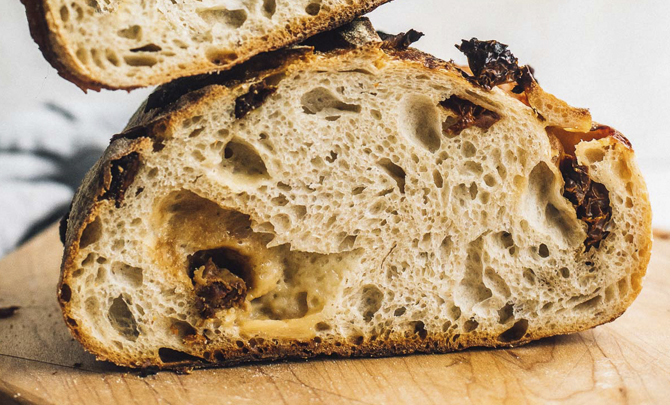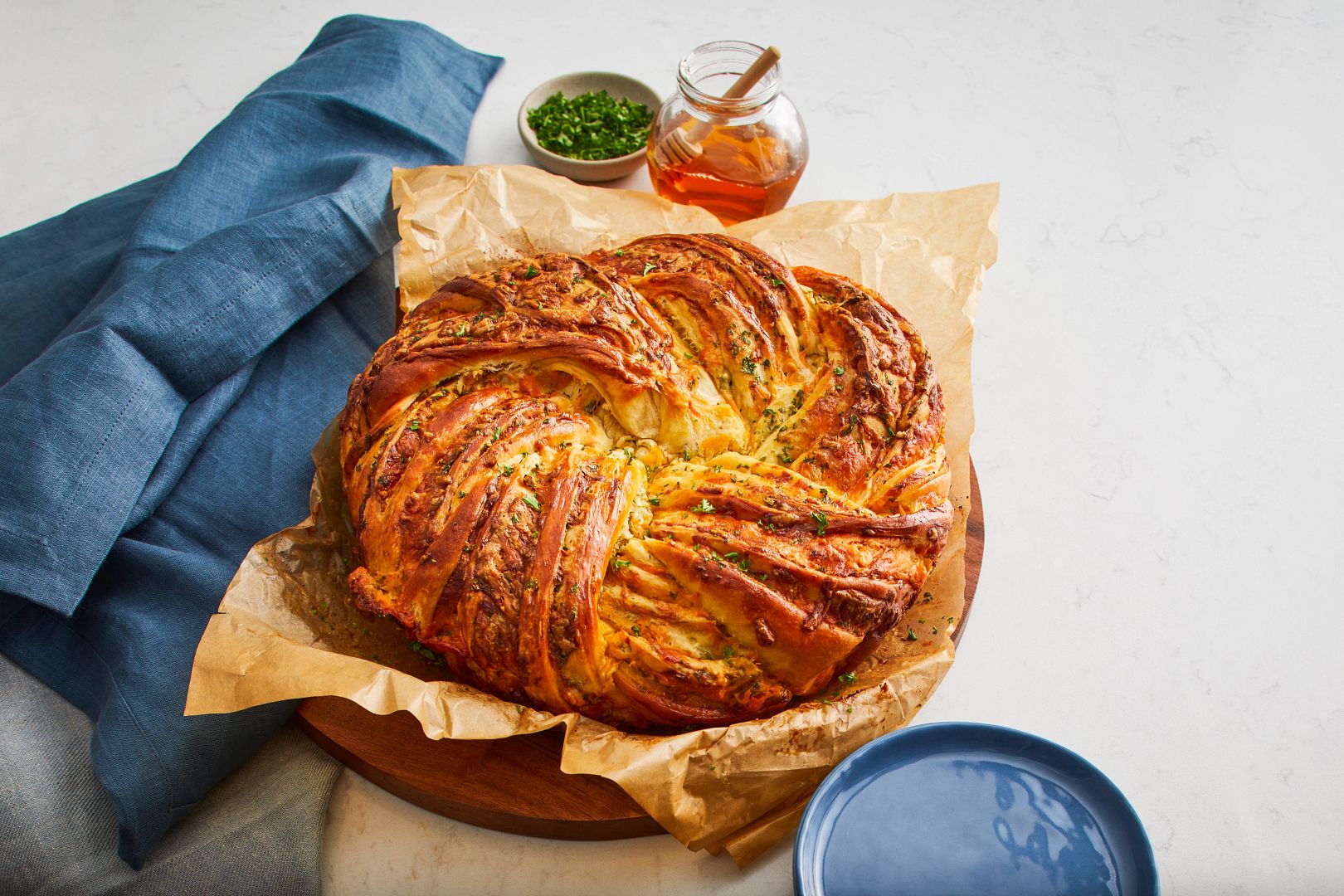Sun-Dried Tomato & Cheddar Gruyere Sourdough Bread
Prep Time
20
Cook Time
45
Difficulty
Intermediate
Servings
1 loaf
Cuisine Type
Cheese Types

Recipe Description
This recipe makes the tastiest loaf of Sun-Dried Tomato & Cheddar Sourdough with pockets of cheese and pops of sweet-tart tomatoes in each bite.
Ingredients
- 60 grams active sourdough starter
- 310 grams filtered water little warmer than room temp
- 370 grams organic bread flour
- 30 grams whole wheat flour
- 7 grams fine sea salt
- 90 grams Wood River Creamery Original Cheddar Gruyere or Herbs de Provence, cut into 1/4 to 1/2 inch cubes
- 40 grams plain sun-dried tomatoes not in oil
Preparation
In a large bowl, mix starter and water with a fork, until starter is dispersed.
Add flours, mixing with a spatula first. Then with your hand until a shaggy dough is formed, just enough so that flour is not visible.
Sprinkle salt on top of the dough. Cover bowl with a damp cloth and let sit for 40 minutes to an hour. While the dough is resting, rehydrate the sun-dried tomatoes by pouring boiling water over the top of them in a bowl.
Now work the salt into the dough, as you perform your 1st set of stretch and folds. Then let rest for a half-hour. Perform two more sets of stretch and folds, waiting the 30 minutes in between for each. In essence, you are doing a total of three sets of stretch and folds over the course of 1 1/2 hours.
After you have completed your 3rd set stretch and folds, wait another 30 minutes.
Drain and rinse the sun-dried tomatoes (important because some brands dry theirs with salt, which needs to be rinsed off or you will have very salty bread). Pat slightly dry, and chop into pieces.
Now you will add the mix-ins. To do this, use a dough scraper to gently remove your dough from the bowl onto a lightly floured surface. Use your hands to gently stretch the dough out into a rectangle about 12 inches X 14 inches. Distribute the cubes of cheese and sun-dried tomatoes over the inside of the dough, leaving about a 1-inch border. Gently pat the ingredients with your hands so that they stick to the dough.
Using lightly floured hands, gently pull one long side of the dough out, and over 1/2 of the dough. Do the same with the other long side of the dough, so both meet in the middle. Now you’ll have a long cylinder-like log. Gently roll the dough up so it is a round shape and put the dough back into the bowl. This step doesn’t have to be perfect, it isn’t the final shaping.
Let the dough bulk ferment on your counter, covered with a damp cloth for about 5-6 hours if your house is around 70 degrees. It will take more time if it is cooler, or less time if it is warmer.
When your dough has grown about 40-50%, has a smoother top and bubble or two peeking out the top, it is ready for shaping.
Gently move the dough out of the bowl onto a floured work surface. Let the dough rest for 10-15 minutes. Then, shape the dough. Once shaped, use a bench scraper to put the dough into a rice flour dusted banneton (proofing basket), seam side of the dough facing up.
Cover with a damp cloth, and let rise for a final time, either on the counter which will take about two hours if your house is around 70 degrees - OR you can put it in the refrigerator in a garbage bag, and let the final rise happen overnight. The dough can be in the refrigerator for 8-10 hours at this stage. (If you do the final rise in the fridge, score and bake straight from the fridge. This makes it easier to score and hold its shape.)
Once your dough has gone through its final rise and has risen 30-40% and is puffy on top, you’re ready to bake. You can test to see if your dough is ready by doing gently pressing a floured thumb into the dough. If it indents and gradually releases, but still holds a finger shape, you're ready. If it indents and doesn't release at all, it still needs time to rise. Let it ferment in half-hour more increments, until ready.
Preheat your oven with a dutch oven inside of it, to 500°F.
Wait until the oven is preheated, then place the parchment over the top of your dough and flip over, so that the seam side is now on the parchment paper and you are able to score the top of the dough. Score the dough with a bread lame, making sure to go at least 1/2 inch deep in a few spots so that dough can release gases. Otherwise, your bread will not rise.
Place dough on parchment paper into the dutch oven, and put the cover on it. Turn heat down to 475°F and bake for 25 minutes, covered. Then remove the cover, turn the oven down to 435°F and bake for 15-20 more minutes, until bread is golden brown and crackly.
Remove from oven and place loaf on a cooling rack. Let cool for AT LEAST ONE HOUR before slicing. Otherwise, the crumb will be squished and the texture will be gummy.
**Recipe creation and photo: Heartbeet Kitchen
**Read more about this recipe here.



